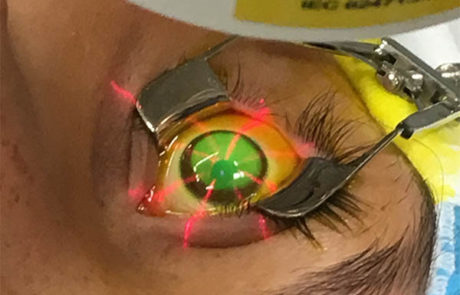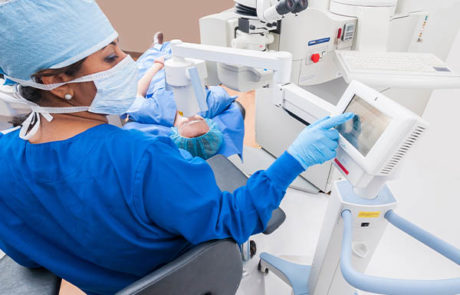What is Corneal Crosslinking?
Corneal crosslinking is a treatment proven effective for keratoconus and other corneal ectatic disorders. These are diseases that cause progressive changes in the shape of the cornea, including steepening and thinning of the corneal shape.
Hill Vision Services is one of a limited number of ophthalmology practices in the Midwest to be part of the Avedro Center of Excellence network. We offer Avedro KXL corneal crosslinking, utilizes the only medication, ultraviolet (UV) lamp, and protocol approved by the FDA specifically for treatment of keratoconus and corneal ectasia.
Hill Vision Services takes great pride in being at the forefront of this exceptional advancement in the treatment of keratoconus and other corneal ectatic diseases.
What is Keratoconus?
Keratoconus is a form of corneal ectasia, an eye disease that causes the cornea to thin and bulge. Normally, the front of the eye is round, but in patients with keratoconus, pressure from within the eye pushes out through the thin area and a cone shape develops.
Keratoconus is a progressive disease that affects both eyes, although sometimes asymmetrically. Signs typically begin when a person is in their late teens or early 20s, but can go unnoticed or undiagnosed for many years.
The cornea is often referred to as the “window to the eye.” The shape of the cornea determines how light is directed into the eye. As the shape of the cornea changes due to keratoconus, those with this condition become increasingly nearsighted and may develop sensitivity to light. The shape of the cornea also becomes more irregular, leading to progressively worsening vision that may become difficult to correct with glasses or contacts.
Without treatment, vision can be significantly affected. The bulge in the cornea becomes worse. Eventually, if severe cases are left untreated, a corneal transplant may be the only available solution.

What Happens During Corneal Crosslinking?
The science behind corneal crosslinking is remarkable. It has been discovered that a certain wavelength of UV light combined with riboflavin (vitamin B2) can add bonds between bundles of collagen fibers in the cornea. This change induced by the procedure, strengthens the fibers of the cornea, making it more rigid and allowing the weakened area to stabilize. Corneal crosslinking is the only treatment that has been shown to halt or slow the progression of keratoconus. There is no other treatment to stop the disease from getting worse.
Dr. Hill uses only safe, FDA-approved products and techniques. Crosslinking can be done in our Hill Vision Services office and takes anywhere from one hour to 90 minutes to complete. Typically, the procedure is done one eye at a time.
To begin, you’ll receive numbing drops in your eye and a medication to calm you. Both will ensure that you will remain comfortable throughout the procedure.
Once the anesthetic drops have numbed your eye, the epithelial surface, sometimes referred to as the “skin” of your cornea, will be painlessly removed.
Riboflavin drops are placed in the eye every 2 minutes. After about 30 minutes, when the riboflavin has had an opportunity to penetrate the tissues of your cornea, you will lay back in a chair and look up at a bright light. A small and relatively comfortable device will be used to hold your eyelids open so that you won’t have to worry about blinking during the procedure. The Avedro KXL UV lamp will target a controlled amount of a specific type of UV light onto the cornea. This machine is the only technology of its kind to be FDA-approved for this use.
After exposure to UV light for 30 minutes, Dr. Hill will place a special contact lens in your eye to protect it as it heals. You will also receive a prescription for anti-inflammatory drops and topical antibiotic eye drops.
The numbing drops will make the crosslinking procedure itself a comfortable experience. Dr. Hill and his staff will continue to talk with you every step of the way so that you don’t have to feel anxious about the process. Before you know it, the procedure will be complete and, after a brief evaluation and instruction, you will be free to leave with a designated driver.
What Happens After a CXL Procedure?
Following crosslinking, you will likely feel discomfort once the numbing drops wear off. Most patients report a burning sensation, or feel as if something is stuck in their eye. As tempting as it feels, it is important to avoid rubbing the eye. Artificial tears and pain relievers can ease your discomfort.
Call Dr. Hill right away if you experience severe or sudden pain, or if your lens falls out or becomes dislodged. Do not try to replace a displaced lens yourself.
Vision will be blurry as the cornea heals, it is not unusual for vision to become worse or for eyes to become more sensitive to light for about 1 month following a KXL procedure.
Though the goal of crosslinking is to stop the progression of disease, some patients report that their vision does improve over time, most often due to the cornea returning to a more natural shape. Many people find that they need new glasses or contact prescriptions following crosslinking because their vision has noticeably changed.
Signs & symptoms of Keratoconus
usually first appear in the late teens and early twenties
Excessively Rubbing Eyes
Mildly Blurred Vision
Difficulty Seeing at Night
Frequent Changes in Eyeglasses Prescription
Frequent Headaches
Vision that Cannot Be Corrected with Glasses
Does Crosslinking Cure Keratoconus?
Corneal crosslinking halts the progression of keratoconus. It does not repair the damage that has already been done. It can help you to avoid a cornea transplant, however, which is a significant benefit.
Is Corneal Crosslinking Safe?
Like any medical procedure, corneal crosslinking comes with risk of infection, and the possibility that your unique body may not heal or react predictably to the treatment. Dr. Hill will review any potential risks or undesired outcomes during your consultation.
Risks can’t be avoided, but they can be mitigated, which is why it is important to consult an ophthalmologist who is experienced in and dedicated to proper diagnosis and treatment for keratoconus and related eye diseases.
Dr. Hill will thoroughly assess your individual situation, including any health issues that may impair the healing process or put you at undue risk for infections or complications. Some risk factors include, but are not limited to, uncontrolled diabetes or autoimmune disease, as well as an advanced level of corneal diseaset.
Prior to undergoing treatment, Dr. Hill will assess all of the information needed to ensure you are a good candidate, and to help you make an informed decision regarding the future of your vision and the health of your eyes.
We are here to serve you.

Dr. Geoffrey Hill is among the very first cornea specialists to perform only FDA-approved corneal crosslinking in the greater St. Louis area.
At Hill Vision Services, we provide a full range of cornea treatments and procedures. Dr. Hill is one of only a few ophthalmologists in Missouri to use only the techniques, medications, and equipment approved for use in corneal crosslinking by the U.S. Food and Drug Administration.







